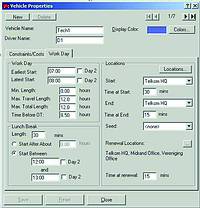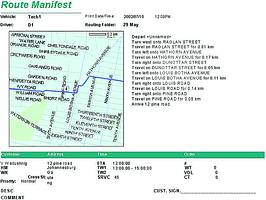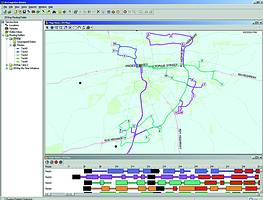Complete logistics and routing solution
1 August 2002
GIMS recently announced the release of ESRI's ArcLogistics Route 3, in conjunction with a South African street database.
This is available for selected metropolitan areas and forms a complete logistics and routing solution aimed at logistics and fleet managers. It offers a solution that will help businesses and organisations deliver goods or services more efficiently, reduce costs and improve customer service. ArcLogistics Route will, furthermore, integrate with existing GIS or Corporate information systems such as SAP R/3.
ArcLogistics Route is a complete, out-of-the-box solution for complex vehicle routing and scheduling problems. ArcLogistics Route uses actual network drive times instead of straight-line (Euclidian) distances. This results in accurate estimates for route sequencing with an associated reduction in mileage. The scheduling results can be viewed with other spatial data to visualise the interrelationships between logistical and other relevant information.
The objective of ArcLogistics Route is to determine which vehicle should serve each stop in such a way that time window violations are minimised, total travel time by the fleet is minimised, and vehicles do not exceed their volume/weight capacity. In addition, an intelligent geocoder automatically matches a delivery address to a location in the organisation's service area, eliminating time wasted attempting to make a delivery to an incorrect address.

Vehicle properties
ArcLogistics Route builds intelligent routes based on actual network drive times, taking into account characteristics of vehicles and customer orders. The scheduler specifies the start, renewal points, and end locations of each vehicle; the capacity of the vehicle; start times, maximum orders, length of workday, and specialty of the vehicle or driver.

Summary of route, times and customer details
The scheduler can also specify exactly how long a route lasts, determine lunchtime within a time window, and assign orders and vehicles as many specialties as desired. Other parameters that can be specified include the volume and weight of items, service time, and requested time window. Based on information entered by the scheduler, ArcLogistics Route constructs a route that optimises time and space usage. By assigning orders to appropriate vehicles and drivers, delivery costs are reduced and better service to customers is provided. Grace periods and second time windows are also available to optimise the routing solution when working with a complex logistical problem.

Routes and time windows for each route
Businesses and organisations can tailor ArcLogistics Route to their needs with driver/vehicle specialties, operating costs, and custom reports. Users can also connect to popular databases through the ODBC standard and directly to SAP R/3. Using Seagate's Crystal Reports, route summary reports, stop vicinity and route overview maps, street-level directions, and driver manifests can be generated. After finalising the routing schedule, users can export routes and schedules back to their databases.
Street Data for the following metropolitan areas is available for use with ArcLogistics Route:
* Gauteng.
* Cape Metropolitan Area including Paarl and Stellenbosch.
* Port Elizabeth.
* East London.
* Durban and Pietermaritzburg.
* Bloemfontein.
* Cape Metropolitan Area including Paarl and Stellenbosch.
* Port Elizabeth.
* East London.
* Durban and Pietermaritzburg.
* Bloemfontein.
This data offers a navigable geo-coded street database for South African metropolitan areas. Shipped in Hartebeeshoek94 format, it includes variables such as overpasses, underpasses, one-way streets, speed limits and turn restriction conditions. The dataset, furthermore, includes address-coded street, which allows one to locate customers/deliveries based on street addresses.
How does ArcLogistics Route build routes?
ArcLogistics Route builds routes by using the following processes:
* Clustering: The orders are grouped into clusters that will form a first set of trial routes. ArcLogistics Route uses seed locations to build clusters. If the user does not provide a seed location for a vehicle, ArcLogistics Route will use geometry to find a good centre for that vehicle's cluster.
* Sequencing: ArcLogistics Route puts the orders on each route in the best sequence by moving orders earlier or later on the route.
* Swapping: ArcLogistics Route moves orders from one route to another to find the best assignment of orders to routes.
Clustering is done once to get a first set of trial routes. Sequencing and swapping are automatically done many times, until the best schedule is determined, based on user costs and time window importance.
ArcLogistics Route is available for Windows 95, 98, 2000, and Windows NT 4.0/2000 or higher. An Intel Pentium III processor or higher and 128 MB of RAM is recommended.
For more information: GIMS, 011 695 0400.
Others who read this also read these articles
An intelligent, integrated approach
MapIT has crafted a Licensed Partner programme based on the common requirement for highly accurate mapping data[ October 2004 ]
Picture it ...
MarketScope can calculate virtually any demographic scenario for your marketplace, taking into account a variety of factors, including your customer profiles, census information, competitor analysis data and any other set of business-related statistics you wish to evaluate, and visually display the results, arriving at an answer within 30 seconds[ August 2004 ]
Mondi develops advanced GIS business system
Mondi Forests has a truly integrated GIS business system that not only takes care of daily operational requirements, but also facilitates the use of GIS decision-making technology[ June 2003 ]
Implementation of a GIS system in local government
The most cost effective and user friendly way of implementing the MIS system and making it accessible to all authorised officials and Councillors throughout the Municipality was to build a Web application using Bentley Publisher[ April 2003 ]
GIS technology saluted for social and economic contributions
GIS is a powerful analytical tool that integrates spatial (or location) data with associated information, presenting the result in an easy-to-understand, map-based format[ February 2003 ]
ArcGIS Schematics launched
ArcGIS Schematics offers a high degree of flexibility and is not limited by the evolution of the data model and by changing database locations[ February 2003 ]
Building a locations-based service
Before we can start any project, we need to know and understand what the system is going to be used for[ August 2002 ]
Sustainable fisheries and marine conservation in Kenya
A Microsoft Access database is being developed to manage the data[ August 2002 ]
Others who read this also read these news items
Hikers, bikers and urban street pioneers
[ December 2005 ]
Image compression provides post-Katrina aerials within days
[ December 2005 ]
Navigation - the tip of the GIS iceberg
[ October 2005 ]
Fun and affordable in-car navigation
[ October 2005 ]
Cycling on the edge
[ October 2005 ]
Routing made easy
[ August 2005 ]
MapIT expands into West Africa
[ August 2005 ]
Incredible Connection powers navigation tools
[ August 2005 ]
Others who read this also read these regulars
ArcIMS 9.1 Route Server - routing and geocoding
[ October 2005 ]
Enterprise GIS with ArcGIS 9: a comprehensive GIS platform
[ October 2004 ]
GIS in Africa
[ August 2003 ]
ESRI offers highly integrated GIS solutions
[ April 2002 ]
GIS - the tool to help manage change in the 21st century
[ April/May 2000 ]
GIS software that sets a new standard
[ April/May 2000 ]
Search Site
Subscribe
Previous Issues
Other Technews Publications
Other Technews Buyers Guides
 |  | Copyright c1995-2009 Technews Publishing (Pty) Ltd.. All rights reserved. |